Service schedule FIAT DUCATO 244 2005 3.G Owners Manual
[x] Cancel search | Manufacturer: FIAT, Model Year: 2005, Model line: DUCATO 244, Model: FIAT DUCATO 244 2005 3.GPages: 258, PDF Size: 4.05 MB
Page 34 of 258
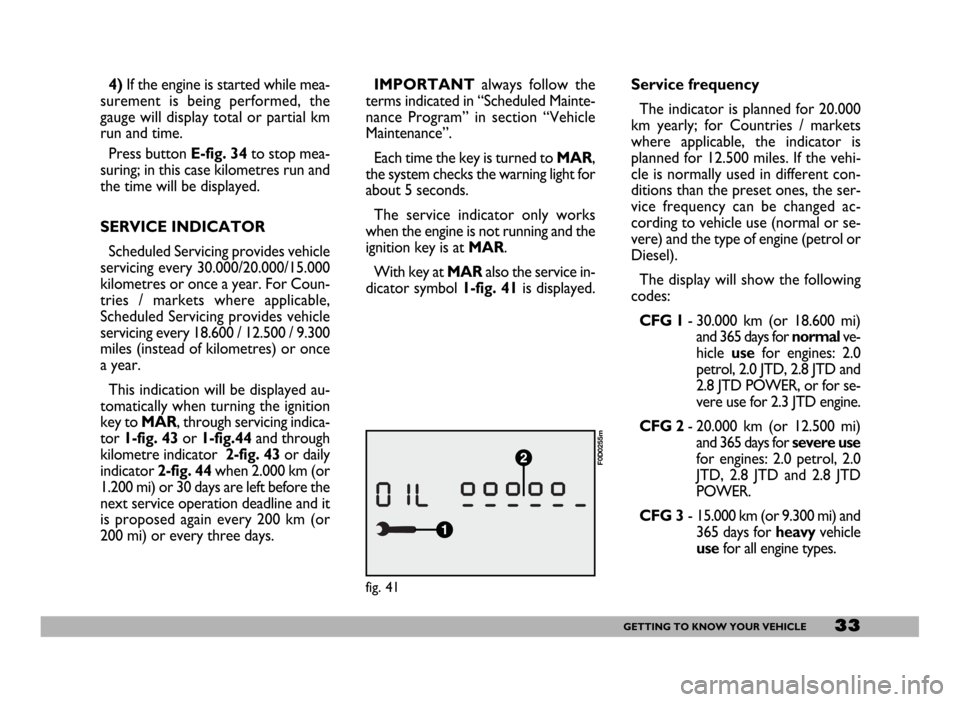
33GETTING TO KNOW YOUR VEHICLE
4)If the engine is started while mea-
surement is being performed, the
gauge will display total or partial km
run and time.
Press button E-fig. 34to stop mea-
suring; in this case kilometres run and
the time will be displayed.
SERVICE INDICATOR
Scheduled Servicing provides vehicle
servicing every 30.000/20.000/15.000
kilometres or once a year. For Coun-
tries / markets where applicable,
Scheduled Servicing provides vehicle
servicing every 18.600 / 12.500 / 9.300
miles (instead of kilometres) or once
a year.
This indication will be displayed au-
tomatically when turning the ignition
key to MAR, through servicing indica-
tor 1-fig. 43or 1-fig.44and through
kilometre indicator 2-fig. 43or daily
indicator 2-fig. 44when 2.000 km (or
1.200 mi) or 30 days are left before the
next service operation deadline and it
is proposed again every 200 km (or
200 mi) or every three days.
fig. 41
F0D0255m
IMPORTANTalways follow the
terms indicated in “Scheduled Mainte-
nance Program” in section “Vehicle
Maintenance”.
Each time the key is turned to MAR,
the system checks the warning light for
about 5 seconds.
The service indicator only works
when the engine is not running and the
ignition key is at MAR.
With key at MARalso the service in-
dicator symbol 1-fig. 41is displayed.Service frequency
The indicator is planned for 20.000
km yearly; for Countries / markets
where applicable, the indicator is
planned for 12.500 miles. If the vehi-
cle is normally used in different con-
ditions than the preset ones, the ser-
vice frequency can be changed ac-
cording to vehicle use (normal or se-
vere) and the type of engine (petrol or
Diesel).
The display will show the following
codes:
CFG 1- 30.000 km (or 18.600 mi)
and 365 days for normalve-
hicle usefor engines: 2.0
petrol, 2.0 JTD, 2.8 JTD and
2.8 JTD POWER, or for se-
vere use for 2.3 JTD engine.
CFG 2- 20.000 km (or 12.500 mi)
and 365 days for severe use
for engines: 2.0 petrol, 2.0
JTD, 2.8 JTD and 2.8 JTD
POWER.
CFG 3- 15.000 km (or 9.300 mi) and
365 days for heavyvehicle
usefor all engine types.
Page 35 of 258

34GETTING TO KNOW YOUR VEHICLE
Service deadline
2.000 km (1.200 mi) before
next service deadline
When scheduled servicing (coupon)
is approaching forecast deadline (2.000
km or 1.200 mi), turn the ignition key
to MAR, and servicing indicator 1-
fig. 43or 1-fig. 44followed by the
number of kilometres (or miles) 2-
fig. 43or the number of days 2-
fig. 44, before vehicle servicing dead-
line will flash for 5 seconds on the ser-
vicing indicator display.After these 5 seconds, the odome-
ter will return to normal operation
and display 2will show either the to-
tal or partial kilometres or total or
partial miles (according to setting).
The information about scheduled
servicing is provided in kilometres (km
or mi) or days, depending on the dead-
line appearing the first. Contact Fiat
Dealershipwho will provide to per-
form the operations provided by the
scheduled servicing and to reset dis-
playing.
fig. 43
F0D0220m
Configuration procedure
To change the service frequency with
the vehicle stationary, turn the ignition
key to MARand press button E-
fig. 34for about 10 seconds: the dis-
play will show the wrench symbol and
the message “CFG 1” or “CFG 2” or
“CFG 3” fig. 42. Press briefly button
Eto set the required configuration,
then press it again for about 5 seconds
to store the new service frequency;
the display will show again clock and
km or miles.
fig. 42
F0D0219m
fig. 44
F0D0250m
Page 125 of 258
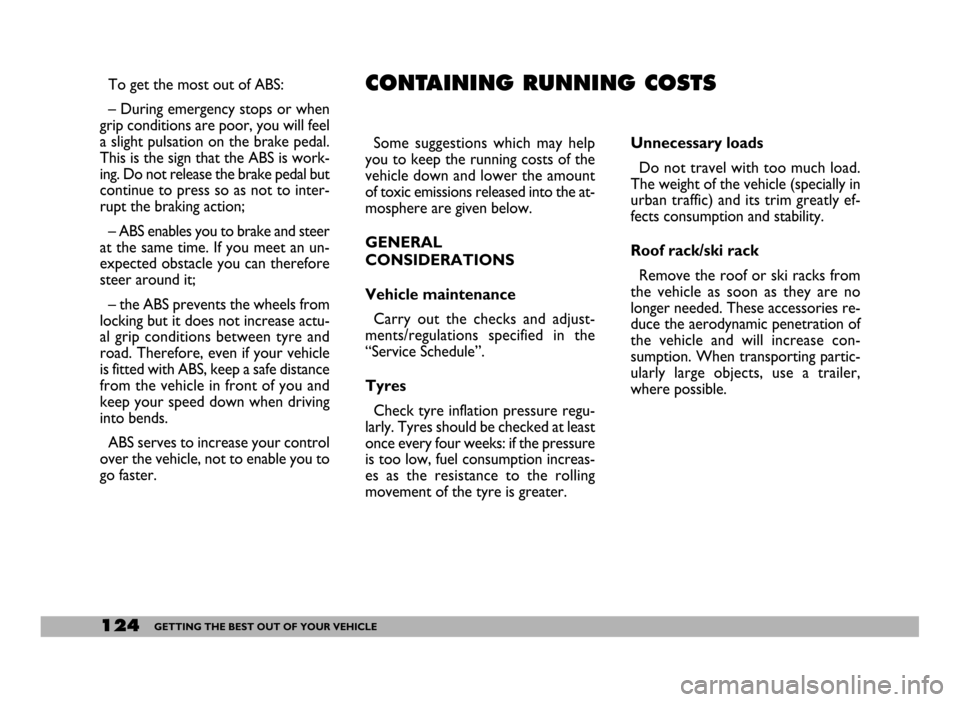
124GETTING THE BEST OUT OF YOUR VEHICLE
To get the most out of ABS:
– During emergency stops or when
grip conditions are poor, you will feel
a slight pulsation on the brake pedal.
This is the sign that the ABS is work-
ing. Do not release the brake pedal but
continue to press so as not to inter-
rupt the braking action;
– ABS enables you to brake and steer
at the same time. If you meet an un-
expected obstacle you can therefore
steer around it;
– the ABS prevents the wheels from
locking but it does not increase actu-
al grip conditions between tyre and
road. Therefore, even if your vehicle
is fitted with ABS, keep a safe distance
from the vehicle in front of you and
keep your speed down when driving
into bends.
ABS serves to increase your control
over the vehicle, not to enable you to
go faster.Some suggestions which may help
you to keep the running costs of the
vehicle down and lower the amount
of toxic emissions released into the at-
mosphere are given below.
GENERAL
CONSIDERATIONS
Vehicle maintenance
Carry out the checks and adjust-
ments/regulations specified in the
“Service Schedule”.
Tyres
Check tyre inflation pressure regu-
larly. Tyres should be checked at least
once every four weeks: if the pressure
is too low, fuel consumption increas-
es as the resistance to the rolling
movement of the tyre is greater.Unnecessary loads
Do not travel with too much load.
The weight of the vehicle (specially in
urban traffic) and its trim greatly ef-
fects consumption and stability.
Roof rack/ski rack
Remove the roof or ski racks from
the vehicle as soon as they are no
longer needed. These accessories re-
duce the aerodynamic penetration of
the vehicle and will increase con-
sumption. When transporting partic-
ularly large objects, use a trailer,
where possible.CONTAINING RUNNING COSTS
Page 129 of 258
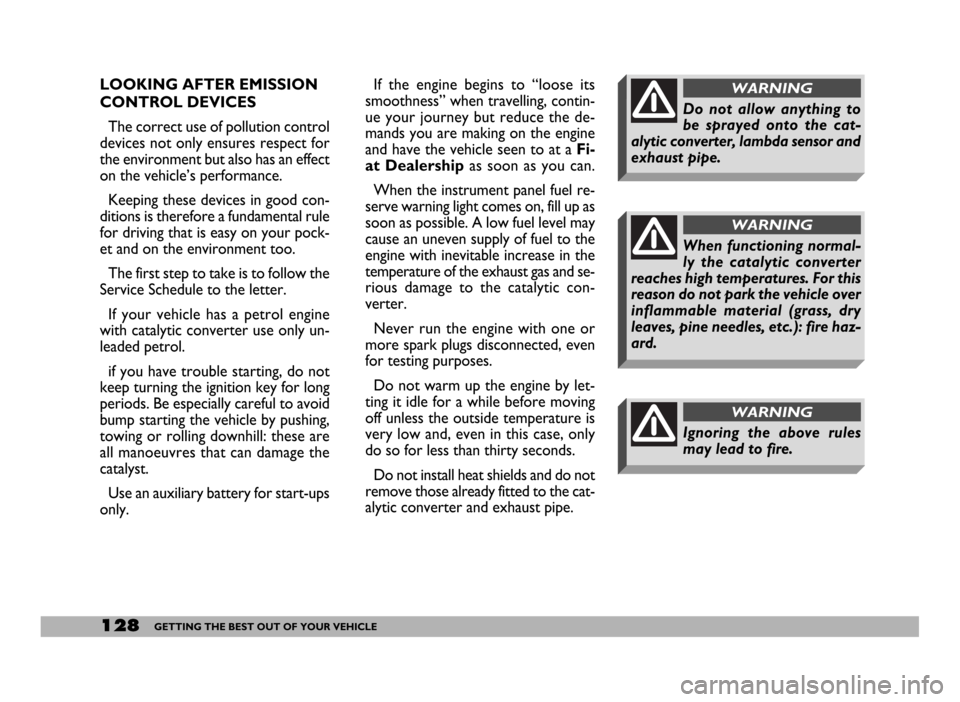
128GETTING THE BEST OUT OF YOUR VEHICLE
LOOKING AFTER EMISSION
CONTROL DEVICES
The correct use of pollution control
devices not only ensures respect for
the environment but also has an effect
on the vehicle’s performance.
Keeping these devices in good con-
ditions is therefore a fundamental rule
for driving that is easy on your pock-
et and on the environment too.
The first step to take is to follow the
Service Schedule to the letter.
If your vehicle has a petrol engine
with catalytic converter use only un-
leaded petrol.
if you have trouble starting, do not
keep turning the ignition key for long
periods. Be especially careful to avoid
bump starting the vehicle by pushing,
towing or rolling downhill: these are
all manoeuvres that can damage the
catalyst.
Use an auxiliary battery for start-ups
only.If the engine begins to “loose its
smoothness” when travelling, contin-
ue your journey but reduce the de-
mands you are making on the engine
and have the vehicle seen to at a Fi-
at Dealershipas soon as you can.
When the instrument panel fuel re-
serve warning light comes on, fill up as
soon as possible. A low fuel level may
cause an uneven supply of fuel to the
engine with inevitable increase in the
temperature of the exhaust gas and se-
rious damage to the catalytic con-
verter.
Never run the engine with one or
more spark plugs disconnected, even
for testing purposes.
Do not warm up the engine by let-
ting it idle for a while before moving
off unless the outside temperature is
very low and, even in this case, only
do so for less than thirty seconds.
Do not install heat shields and do not
remove those already fitted to the cat-
alytic converter and exhaust pipe.
Do not allow anything to
be sprayed onto the cat-
alytic converter, lambda sensor and
exhaust pipe.
WARNING
Ignoring the above rules
may lead to fire.
WARNING
When functioning normal-
ly the catalytic converter
reaches high temperatures. For this
reason do not park the vehicle over
inflammable material (grass, dry
leaves, pine needles, etc.): fire haz-
ard.
WARNING
Page 163 of 258
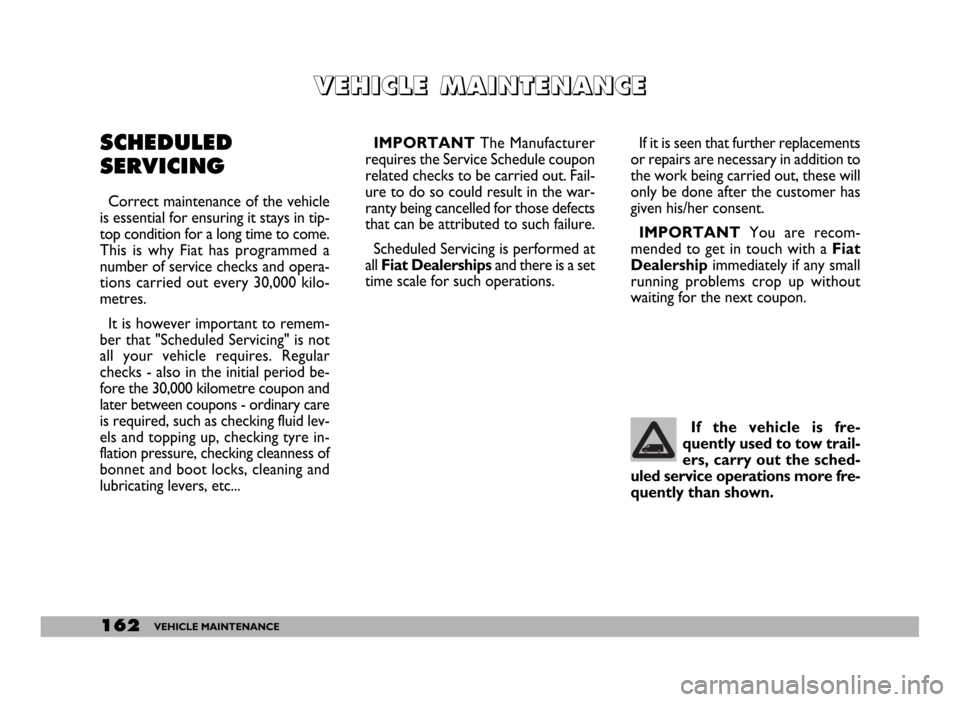
162VEHICLE MAINTENANCE
V V
E E
H H
I I
C C
L L
E E
M M
A A
I I
N N
T T
E E
N N
A A
N N
C C
E E
SCHEDULED
SERVICING
Correct maintenance of the vehicle
is essential for ensuring it stays in tip-
top condition for a long time to come.
This is why Fiat has programmed a
number of service checks and opera-
tions carried out every 30,000 kilo-
metres.
It is however important to remem-
ber that "Scheduled Servicing" is not
all your vehicle requires. Regular
checks - also in the initial period be-
fore the 30,000 kilometre coupon and
later between coupons - ordinary care
is required, such as checking fluid lev-
els and topping up, checking tyre in-
flation pressure, checking cleanness of
bonnet and boot locks, cleaning and
lubricating levers, etc...If it is seen that further replacements
or repairs are necessary in addition to
the work being carried out, these will
only be done after the customer has
given his/her consent.
IMPORTANTYou are recom-
mended to get in touch with a Fiat
Dealershipimmediately if any small
running problems crop up without
waiting for the next coupon.
If the vehicle is fre-
quently used to tow trail-
ers, carry out the sched-
uled service operations more fre-
quently than shown.
IMPORTANTThe Manufacturer
requires the Service Schedule coupon
related checks to be carried out. Fail-
ure to do so could result in the war-
ranty being cancelled for those defects
that can be attributed to such failure.
Scheduled Servicing is performed at
all Fiat Dealershipsand there is a set
time scale for such operations.
Page 164 of 258
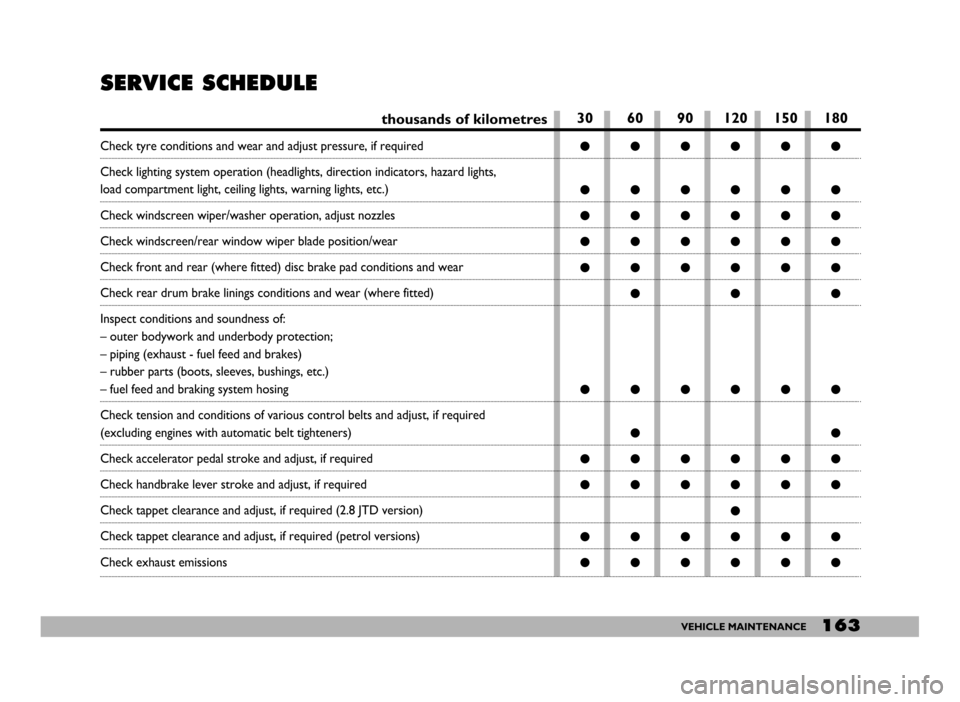
163VEHICLE MAINTENANCE
SERVICE SCHEDULE
thousands of kilometres
Check tyre conditions and wear and adjust pressure, if required
Check lighting system operation (headlights, direction indicators, hazard lights,
load compartment light, ceiling lights, warning lights, etc.)
Check windscreen wiper/washer operation, adjust nozzles
Check windscreen/rear window wiper blade position/wear
Check front and rear (where fitted) disc brake pad conditions and wear
Check rear drum brake linings conditions and wear (where fitted)
Inspect conditions and soundness of:
– outer bodywork and underbody protection;
– piping (exhaust - fuel feed and brakes)
– rubber parts (boots, sleeves, bushings, etc.)
– fuel feed and braking system hosing
Check tension and conditions of various control belts and adjust, if required
(excluding engines with automatic belt tighteners)
Check accelerator pedal stroke and adjust, if required
Check handbrake lever stroke and adjust, if required
Check tappet clearance and adjust, if required (2.8 JTD version)
Check tappet clearance and adjust, if required (petrol versions)
Check exhaust emissions
30 60 90 120 150 180
●●●●●●
●●●●●●
●●●●●●
●●●●●●
●●●●●●
●●●
●●●●●●
●●
●●●●●●
●●●●●●
●
●●●●●●
●●●●●●
Page 167 of 258
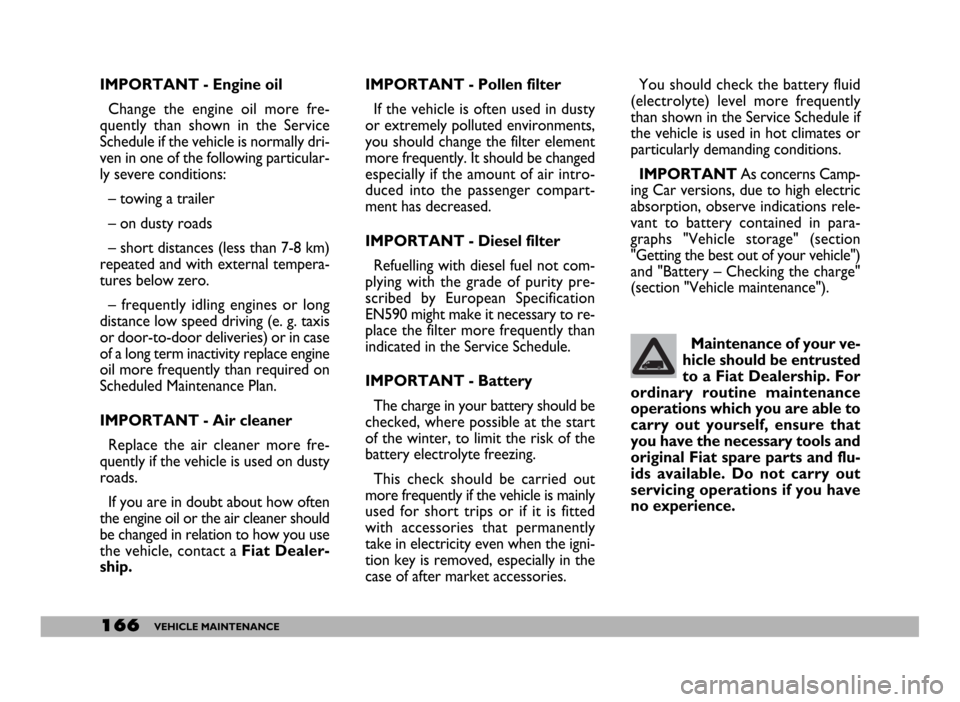
166VEHICLE MAINTENANCE
IMPORTANT - Pollen filter
If the vehicle is often used in dusty
or extremely polluted environments,
you should change the filter element
more frequently. It should be changed
especially if the amount of air intro-
duced into the passenger compart-
ment has decreased.
IMPORTANT - Diesel filter
Refuelling with diesel fuel not com-
plying with the grade of purity pre-
scribed by European Specification
EN590 might make it necessary to re-
place the filter more frequently than
indicated in the Service Schedule.
IMPORTANT - Battery
The charge in your battery should be
checked, where possible at the start
of the winter, to limit the risk of the
battery electrolyte freezing.
This check should be carried out
more frequently if the vehicle is mainly
used for short trips or if it is fitted
with accessories that permanently
take in electricity even when the igni-
tion key is removed, especially in the
case of after market accessories.You should check the battery fluid
(electrolyte) level more frequently
than shown in the Service Schedule if
the vehicle is used in hot climates or
particularly demanding conditions.
IMPORTANTAs concerns Camp-
ing Car versions, due to high electric
absorption, observe indications rele-
vant to battery contained in para-
graphs "Vehicle storage" (section
"Getting the best out of your vehicle")
and "Battery – Checking the charge"
(section "Vehicle maintenance").
Maintenance of your ve-
hicle should be entrusted
to a Fiat Dealership. For
ordinary routine maintenance
operations which you are able to
carry out yourself, ensure that
you have the necessary tools and
original Fiat spare parts and flu-
ids available. Do not carry out
servicing operations if you have
no experience.IMPORTANT - Engine oil
Change the engine oil more fre-
quently than shown in the Service
Schedule if the vehicle is normally dri-
ven in one of the following particular-
ly severe conditions:
– towing a trailer
– on dusty roads
– short distances (less than 7-8 km)
repeated and with external tempera-
tures below zero.
– frequently idling engines or long
distance low speed driving (e. g. taxis
or door-to-door deliveries) or in case
of a long term inactivity replace engine
oil more frequently than required on
Scheduled Maintenance Plan.
IMPORTANT - Air cleaner
Replace the air cleaner more fre-
quently if the vehicle is used on dusty
roads.
If you are in doubt about how often
the engine oil or the air cleaner should
be changed in relation to how you use
the vehicle, contact a Fiat Dealer-
ship.
Page 173 of 258
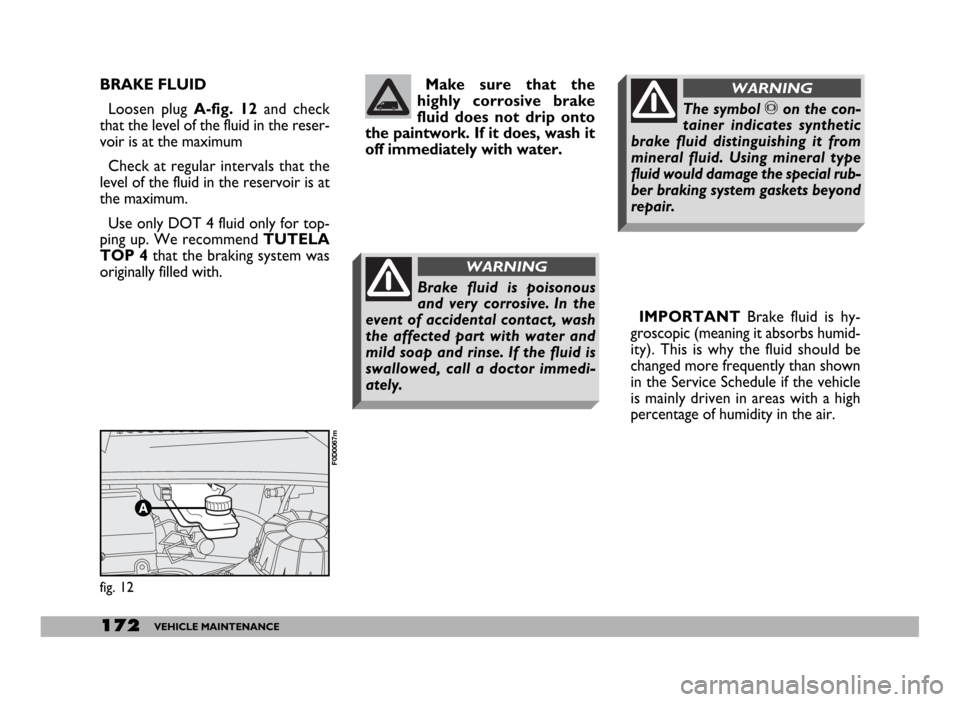
172VEHICLE MAINTENANCE
BRAKE FLUID
Loosen plug A-fig. 12and check
that the level of the fluid in the reser-
voir is at the maximum
Check at regular intervals that the
level of the fluid in the reservoir is at
the maximum.
Use only DOT 4 fluid only for top-
ping up. We recommend TUTELA
TOP 4that the braking system was
originally filled with.
IMPORTANTBrake fluid is hy-
groscopic (meaning it absorbs humid-
ity). This is why the fluid should be
changed more frequently than shown
in the Service Schedule if the vehicle
is mainly driven in areas with a high
percentage of humidity in the air. Make sure that the
highly corrosive brake
fluid does not drip onto
the paintwork. If it does, wash it
off immediately with water.
fig. 12
F0D0067m
The symbol πon the con-
tainer indicates synthetic
brake fluid distinguishing it from
mineral fluid. Using mineral type
fluid would damage the special rub-
ber braking system gaskets beyond
repair.
WARNING
Brake fluid is poisonous
and very corrosive. In the
event of accidental contact, wash
the affected part with water and
mild soap and rinse. If the fluid is
swallowed, call a doctor immedi-
ately.
WARNING
Page 180 of 258
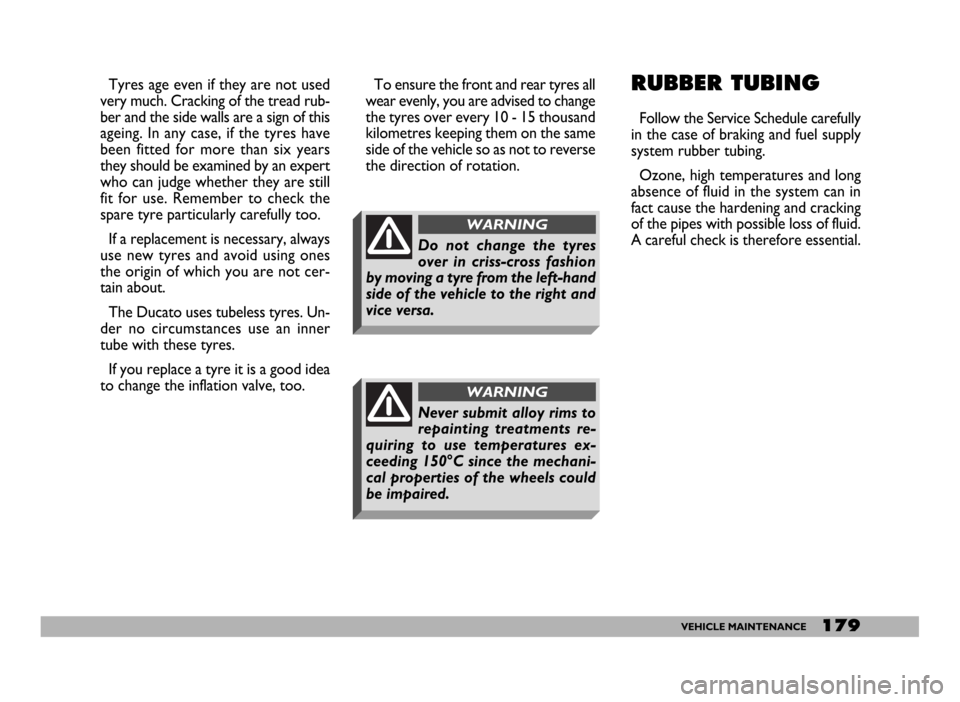
179VEHICLE MAINTENANCE
Tyres age even if they are not used
very much. Cracking of the tread rub-
ber and the side walls are a sign of this
ageing. In any case, if the tyres have
been fitted for more than six years
they should be examined by an expert
who can judge whether they are still
fit for use. Remember to check the
spare tyre particularly carefully too.
If a replacement is necessary, always
use new tyres and avoid using ones
the origin of which you are not cer-
tain about.
The Ducato uses tubeless tyres. Un-
der no circumstances use an inner
tube with these tyres.
If you replace a tyre it is a good idea
to change the inflation valve, too.To ensure the front and rear tyres all
wear evenly, you are advised to change
the tyres over every 10 - 15 thousand
kilometres keeping them on the same
side of the vehicle so as not to reverse
the direction of rotation.RUBBER TUBING
Follow the Service Schedule carefully
in the case of braking and fuel supply
system rubber tubing.
Ozone, high temperatures and long
absence of fluid in the system can in
fact cause the hardening and cracking
of the pipes with possible loss of fluid.
A careful check is therefore essential.
Do not change the tyres
over in criss-cross fashion
by moving a tyre from the left-hand
side of the vehicle to the right and
vice versa.
WARNING
Never submit alloy rims to
repainting treatments re-
quiring to use temperatures ex-
ceeding 150°C since the mechani-
cal properties of the wheels could
be impaired.
WARNING
Page 216 of 258
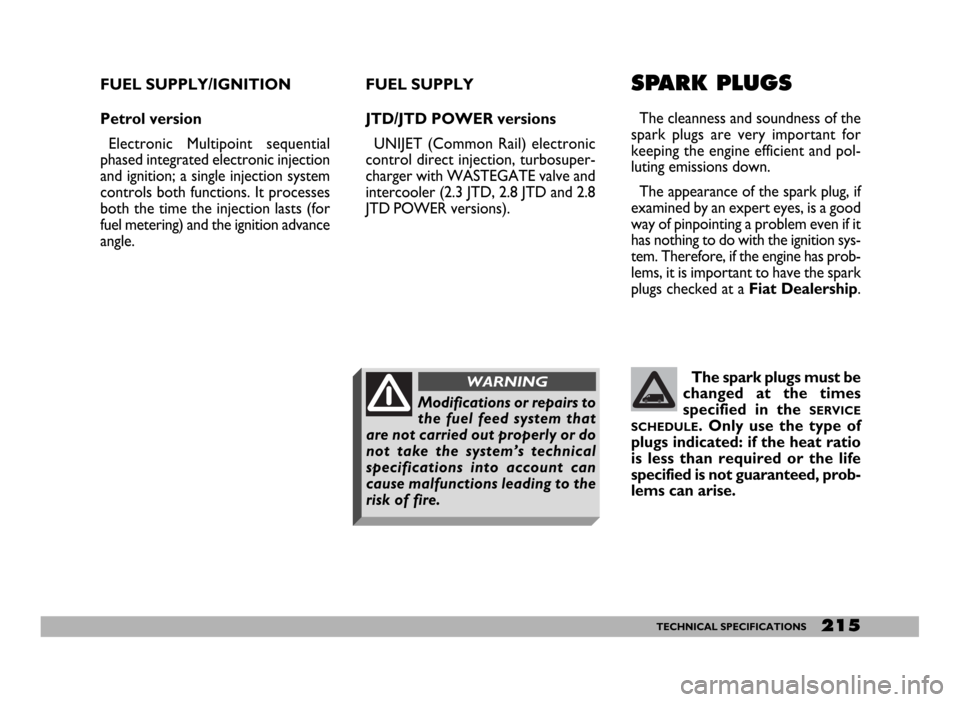
215TECHNICAL SPECIFICATIONS
FUEL SUPPLY/IGNITION
Petrol version
Electronic Multipoint sequential
phased integrated electronic injection
and ignition; a single injection system
controls both functions. It processes
both the time the injection lasts (for
fuel metering) and the ignition advance
angle.FUEL SUPPLY
JTD/JTD POWER versions
UNIJET (Common Rail) electronic
control direct injection, turbosuper-
charger with WASTEGATE valve and
intercooler (2.3 JTD, 2.8 JTD and 2.8
JTD POWER versions).SPARK PLUGS
The cleanness and soundness of the
spark plugs are very important for
keeping the engine efficient and pol-
luting emissions down.
The appearance of the spark plug, if
examined by an expert eyes, is a good
way of pinpointing a problem even if it
has nothing to do with the ignition sys-
tem. Therefore, if the engine has prob-
lems, it is important to have the spark
plugs checked at a Fiat Dealership.
The spark plugs must be
changed at the times
specified in the
SERVICE
SCHEDULE
. Only use the type of
plugs indicated: if the heat ratio
is less than required or the life
specified is not guaranteed, prob-
lems can arise.
Modifications or repairs to
the fuel feed system that
are not carried out properly or do
not take the system’s technical
specifications into account can
cause malfunctions leading to the
risk of fire.
WARNING